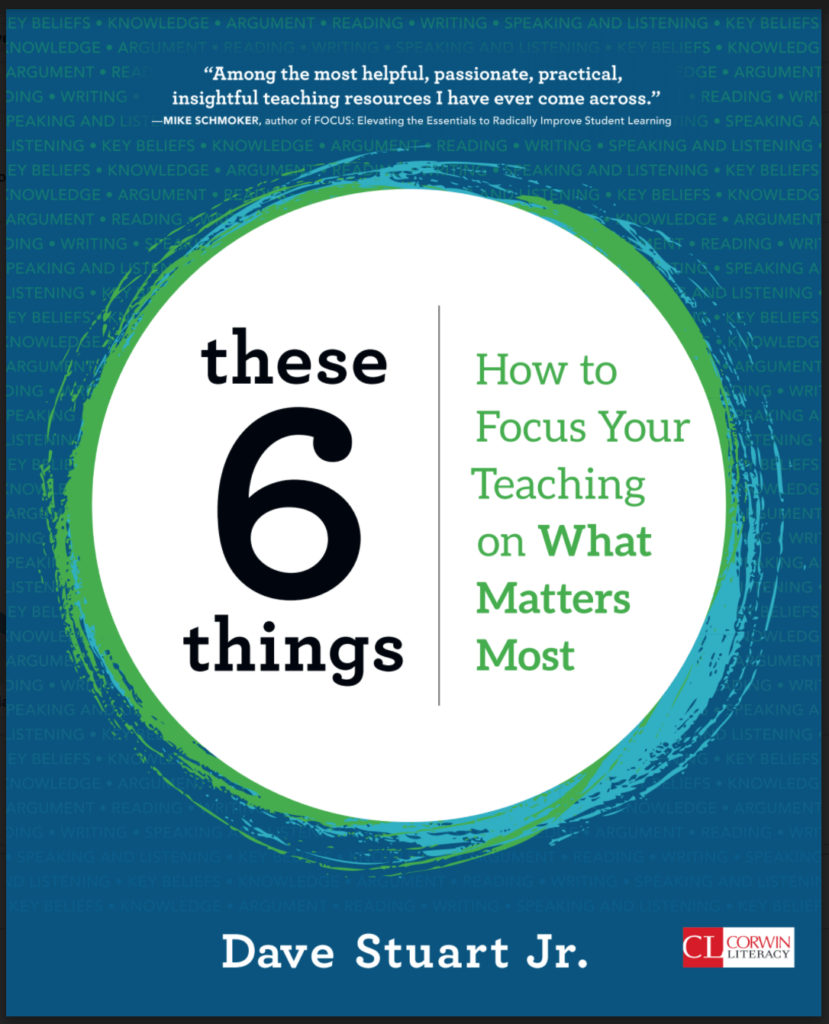Notes from Dave:
I treat pop-up debate extensively in Chapter 4 of These 6 Things: How to Focus Your Teaching on What Matters Most. Teachers around the world tell me it's one of their favorite chapters on argument in any source. Pick up your copy today!
Pop-up Debate is a method for managing and facilitating in-class debates; it is easily modifiable for other speaking scenarios, such as discussions or toasts.
Here's Pop-Up Debate:
- Students use assigned text(s), logic, and/or course content to respond to a debatable prompt and their peers’ arguments using the rules below.
- Every student speaks 1+ times, depending on time constraints. These limits are set by the teacher.
- To speak, students simply “pop up” at their desks and talk. First person to speak has the floor. When multiple students pop up, teach them to politely yield the floor. Argument is a collaborative endeavor, and collaboration isn't a pointed finger and, “Sit down, I was up first.”
This is how simply I introduce it to my students once we've done about three weeks of Think-Pair-Share.
Why Use Pop-Up Debate?
Pop-up debates are a novice-friendly, replicable teaching strategy. They allow me to
- get all students talking about course content;
- explicitly teach students how to speak within an authentic context;
- teach students to argue, which Jerry Graff explains is critical for the democratization of postsecondary attainment (and this is why argument is one of the five things I recommend working on all year long); and
- build character, although I'm still studying exactly how through a national Teacher Innovation Grant (full explanation here).
Management considerations
- No cross talk. The person standing has the floor.
- You are the coach. Model, instruct, encourage, and correct. With discretion.
- Every kid needs to speak. Be proactive with shy kids.
- “Great debaters can debate all sides.” Assign sides once in awhile.
- “We all win with a great debate.” I don't choose winners.
- Teach and assess 1-2 skills at a time. Organize your speaking mini-lessons into three buckets: content, organization, and delivery.
- Explain Erik Palmer's PVLEGS early. Use it all year long.
- Include a reflection at the end. What went well? What didn't? How did we do as a class? What can we do to improve?
- Frequency: I aim to have a debate every 1.5 weeks.
Questions? Comments? Use the comments section below. Learn way more in the Pay-What-You-Want Pop-Up Debate Starter Kit.
OR: check out my 2023-2024 deep dive series on this strategy below.

pradlfan says
I can’t wait to try this out!
Bobbik says
How do you incorporate those students who have not yet acquired the language skills (CELDT levels of 1, 2 or even some 3)?
Steve Goodgame says
I like this. Students enjoy debate, and when we can vary the structure, it can be a great thing. I also use “tennis debate”. I’ll try this out as well thanks for sharing!
Kathy says
Hi Dave! I love your articles and I have learned so much from them. I feel you’ve really helped me to create a mindset of quality teaching with a nod to a healthy balance for a life outside of school. Thank you for all you do! You’re definitely impacting the learning community in a dynamic way. I recommend your site to every teacher I know. Here’s my question: I can’t make it for the Pop-Up Debate webinar. Will I be able to view it at a later date? If so, how would I do that?
Julia says
Hi Dave, we are trying this today as we prepare for Thanksgiving break. Our topic is Based on it’s history, should Thanksgiving still be a federal holiday. I gave them some background information to review on my google classroom site last week and today they were given a few other sources. 1st period was kind of shaky and just as they were getting the hang of it the bell rang. Looking forward to how the rest of the day goes. Thanks for this awesome idea.
davestuartjr says
Julia, I’m so glad it helped!
NaTasha says
Hi Dave, I’m a huge fan of your blog. I use AoW in my classroom, and I often use the Pop-Up Debate strategy for Friday AoW discussions. One of the issues I have with this strategy is that sometimes students fail to build off each other during discussion. They know they need to speak at least once, so they will pop up whenever there is a chance and say their peace, even if what they are saying has nothing to do with the preceding comment. Is there anything I can model or provide as a scaffold to encourage a more natural flow of conversation? Should I provide discussion stems, or is that too structured?
davestuartjr says
Natasha, discussion stems are perfect! I use Paraphrase Plus — see here: http://davestuartjr.com/paraphrase-plus
Bridgette B. says
I just printed the Paraphrase Plus page. I am going to distribute this to my students and utilize it along with the Pop Up Debate strategy on Monday. Thank you for the resources!
davestuartjr says
Bridgette, that is so great to hear. Let me know how it goes
Bekah Vickers says
Dave, I got here from a Google search for “article of the week” after reading Gallagher and Kittle’s 180 Days and deciding to revamp my middle school literature plans…. and now I’ve read a dozen of your posts! Thank you for the wide variety of practical and applicable information – and for your frequent cross-references, which have kept me on your site for at least an hour!
Dave Stuart Jr. says
You’re the dream reader then, Bekah — thank you for hanging in there with a site that is always in progress!